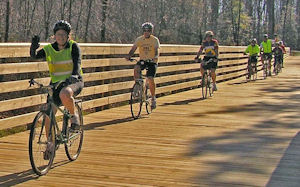Richmond is gaining traction as a bicycle-friendly region but it is a slow and arduous process. Public and private investment in biking infrastructure remain limited, almost non-existent outside the City of Richmond. It is commonly said among cycling enthusiasts that if you build the biking amenities, the cyclists will come. The challenge is persuading government, business and civic decision makers to put money into bicycle amenities at a time when resources are scarce and public needs are many.
The selling proposition for bicycle infrastructure varies from region to region. In California, for instance, green gets the green. Any amenity that reduces automobile traffic and carbon-dioxide emissions moves up the list of priorities. Other than a few enclaves like Arlington and Charlottesville, however, saving the planet from the scourge of global warming doesn’t elicit much enthusiasm in Virginia. In the Old Dominion, people tend to get more stoked about jobs and wealth creation. If you want more bike lanes, parking spaces for bikes, bike-friendly traffic laws and the like, make the link to economic development.
With those thoughts in mind, Bacon’s Rebellion hosted an idea jam at Acorn Sign Graphics last night, attended by a dozen or so cycling activists. Our goal was to bolster the connection between bicycles and economic development. Several themes emerged from the conversation.
Cycling stimulates tourism. As the 50-mile Virginia Capital Trail between Richmond and Williamsburg nears completion, cycling advocates contend that the trail will be an amenity that will draw visitors to the Richmond region. Many look to the example of the Virginia Creeper Trail near Abingdon and biking trails in other states, which have given rise to clusters of outfitters and restaurants. The traffic isn’t exactly in the same league as Las Vegas or Disney World, but bike trails do generate stays at hotels, B&Bs and nearby attractions.
In addition to the Virginia Capital Trail, Richmond MORE and other groups are working to build the existing network of trails along the James River in downtown Richmond into a 40-mile trail network of mountain bike trails. Winning an International Mountain Bicycling Association (IMBA) desgination as a “ride center” will entice mountain bikers to drive four hours or more to stay “just to ride our trails,” says Greg Rollins, president of the volunteer organization.
Cycling trails and property values. Insofar as people regard cycling trails, bike-ped paths and bicycle lanes as desirable amenities, bicycle infrastructure enhances property values. Once upon a time, people paid a premium to live on a golf course, observed Jay Paul, an entrepreneur who has recently rolled out a line of cycling insurance. Today, he suggested people are more likely to pay a premium to live on a bike trail or bike-friendly street.
Investing in bicycle infrastructure can generate a payback for local governments in the form of higher property assessments and stronger tax revenue.
Cycling, place making and livability. Communities across the country are paying increasing attention to the art of “place making,” creating the kinds of places where people like to gather and interact. Great places, which locals cherish and out-of-towners come to visit, have many common elements, including a mix of residential, commercial and retail uses, walkable streets, cool public areas and, increasingly, bicycle access.
An abundance of great places makes a region a fun place to live — and more economically competitive. In the knowledge economy, a relatively small segment of the population — call them knowledge workers, the creative class, whatever you will — contribute disproportionately to wealth creation. A region’s ability to compete depends as much upon its ability to attract these young, educated and often-entrepreneurial workers as it does upon recruiting corporate investment. Indeed, corporations increasingly tend to locate in regions where they can access workers with valuable skill sets.
Young professionals and entrepreneurs are gravitating to Richmond’s urban core not just to work and play but to live. Far fewer own cars than did the previous generation, preferring to rely for mobility upon walking, biking and mass transit. Many won’t consider living anywhere but a walkable, bikable community.
Recruiting these young, foot-loose workers, said Jack Berry, executive director of Venture Richmond, requires “creating an image of a city and community that young people are attracted to. Right now, we’re seen as lagging cool places” like Portland and Boulder, he said. Cycling is a big part of the attraction.
Champe Burnley, president of the Virginia Bicycling Federation, put it another way: “If you want to recruit talent, you don’t do it by taking people to the country club and buying them a martini.” You need to show young people the fun things there are to do.



